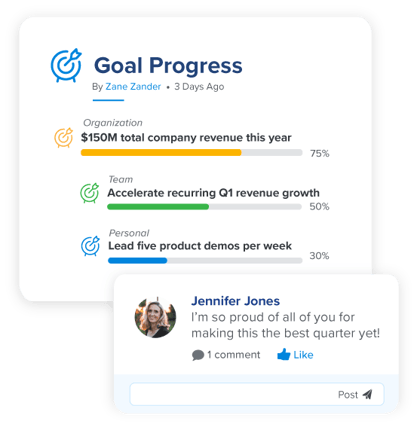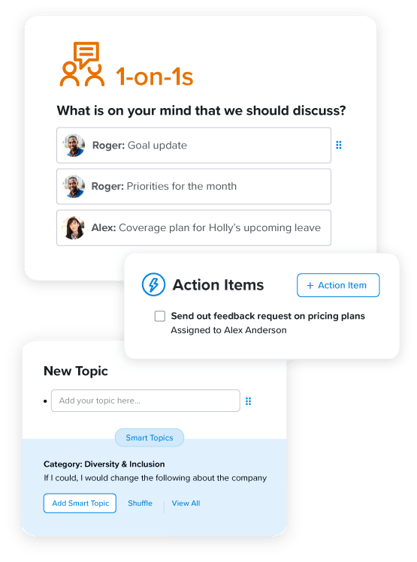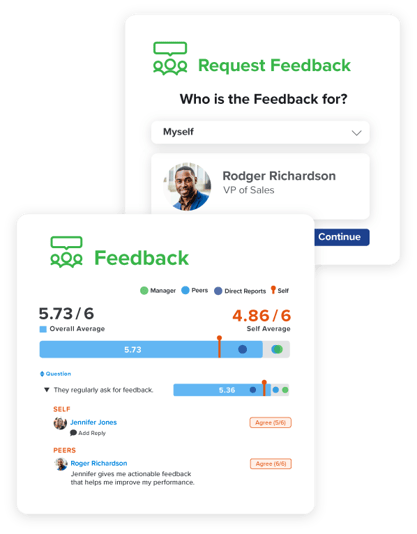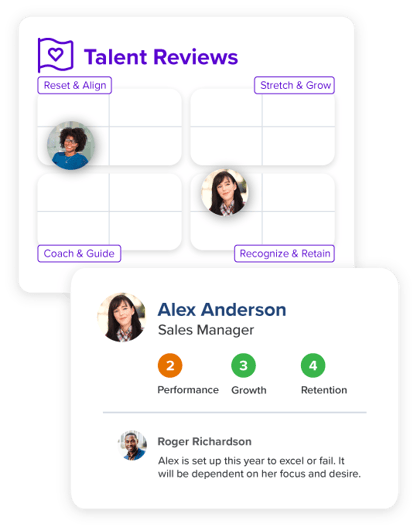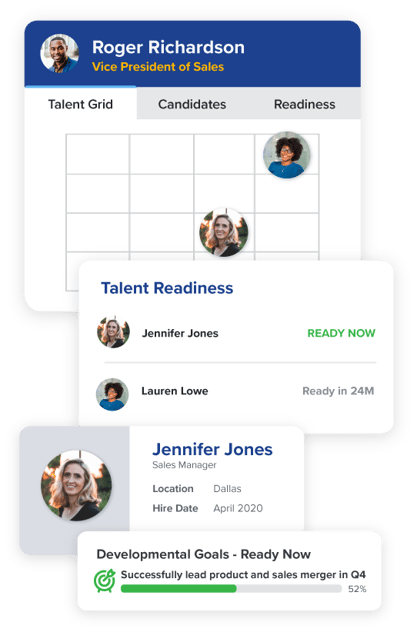How to Select the Best Performance Management System Software in 2025
Digital performance management systems have revolutionized how companies see, measure, and manage employee performance. Effective software makes the entire performance management process easier. Easier for administrators, managers, and employees alike.
But how do you identify which performance management software is best? Finding the right provider isn’t a process you should take lightly. The performance management technology space is crowded and noisy. It can be difficult to know what to look for and what to ask.
In this guide, we discuss important evaluation considerations for your performance management system. And how to identify the best performance management tools for you.
What is a performance management system?
A performance management system includes processes and tools that help employees and businesses gather feedback, grow, and improve. A solid system increases both employee engagement and employee impact. It empowers managers to understand and coach to employee performance with continuous conversations and feedback.
The primary goals of employee performance management software include:
- Elevating employee and team performance
- Aligning your employees with organizational goals
- Creating a high-impact workforce that achieves its goals
💪 Build more effective managers and teams -- get a personalized demo of Quantum Workplace >>
Why do you need performance management system software?
Achieving and sustaining employee success is top of mind for most organizations. It's not just about getting the job done. It's about building a program that drives high performing teams.
If you’re still relying on an annual performance review, you're likely missing the mark. You must evolve beyond a check-the-box process into a streamlined, engaging, and actionable process. A more continuous performance management approach fosters:
- Real-time data collection
- Ongoing performance conversations and coaching
- Strategic alignment with business goals
- Confident and empowered managers
- An engaging employee experience
A cutting-edge employee performance management system is more than just an evaluation tool. It is the base that helps human resources managers and their organizations adapt and improve. This foundation drives performance at every level.
Here are the top reasons why leaders need a performance management system.

1. Measure performance accurately.
Accurate performance measurement is table stakes. But only 36% of employees say they fully understand their job responsibilities and performance expectations, according to Lighthouse Research & Advisory.
A performance management system provides clarity, aligning employee efforts with organizational objectives. This clarity is vital to effective organizational performance.
2. Close employee skill gaps.
Many employees crave more feedback and coaching, with 50% desiring additional feedback. A performance management system empowers leaders to bridge skill gaps and build thoughtful employee development plans. It equips employees with the tools they need to grow and succeed.
3. Discuss and align employee performance goals.
Clearly articulated performance goals are a powerful engagement driver, fostering employee participation in working toward the bigger picture. Our research shows employees with individual goals are twice as likely to be engaged. Performance management help align personal aspirations with organizational objectives.
4. Increase moral and reduce employee turnover.
Recognition and appreciation matter deeply to employees. Only 20% of employees feel recognized and appreciated for their work—and half of all employees (at all levels) desire more recognition. A performance management system empowers employee recognition that boosts employee morale and reduces costly, unwanted turnover.
5. Create trust between managers and employees.
Trust is vital in any successful workplace. Effective performance management creates transparency and fairness. It builds a strong foundation of trust that's essential for strong working relationships. Organizations should actively work to provide employees with feedback, manager connection, and clear visibility into performance.
6. Create a path to growth for all employees.
Every employee should have a clear path to growth and career development within the organization. Performance management systems incorporate details that bring your talent development plans to life. The right system helps you shift talent development from an aspiration to a structured process.
7. Increase company-wide alignment.
Quantum Workplace research shows that performance management significantly impacts culture. Effective performance management systems align team members with your mission, purpose, and goals.
8. Drive important business outcomes.
Ultimately, a performance management system is a strategic tool. Brandon Hall Group reveals that 62% of organizations believe their current performance management processes don't enhance performance. Modern systems drive the outcomes and key results that matter most to your business.
What are key elements of the best performance management software?

Your performance management system should help you plan, monitor, review, and recognize performance. It should encompass the entire performance management cycle. Let’s review each of these capabilities in more detail.
1. Planning
Effective performance management begins with thoughtful planning. Your performance management platform should help define and align employee goals with organizational objectives. Transparent and clear goals help:
- Define expectations and action plans
- Improve collaboration
- Keep employees focused on what matters
- Connect the dots between employee & business success
2. Monitoring
To effectively monitor performance, you need accurate, real-time data and actionable insights. The right system will enable you to track key performance metrics and check in on progress toward goals. Taking a more continuous approach to monitoring can help your teams:
- Identify potential roadblocks early
- Keep employee and team goals on track
- Provide a foundation for data-driven decision making
The goal is to identify and address performance challenges promptly and motivate sustained productivity.
3. Reviewing
The reviewing phase is where the magic happens with employee development. An effective performance management system should facilitate efficient and meaningful employee performance reviews.
These reviews go beyond simple performance appraisals. They provide a platform for managers to engage in constructive conversations with employees. This includes:
- Offering manager and peer feedback and recognition
- Reviewing performance data together
- Understanding and removing obstacles to success
- Collaboratively creating strategies and action items
But reviews aren’t limited to top-down management. The right system will effectively enable 360-degree feedback when and where you need it. This helps you get a more comprehensive view of employee performance.
Your system should simplify the feedback and review process. It should help managers and employees talk openly and productively. Your system should also help you document conversations in a meaningful way so you can easily call up feedback from any time frame.
4. Recognizing
Employee recognition is an important element in driving employee motivation and performance. Your system should equip leaders to acknowledge and recognize employees for their efforts. Effective employee recognition:
- Fosters a positive work environment
- Reinforces desired behaviors
- Inspires employees to deliver their best work
When leaders express public appreciation and recognize outstanding contributions, it creates a culture of excellence and continuous improvement.
Incorporating these four elements into your performance management system ensures it supports the entire performance management cycle. This holistic approach streamlines your process and maximizes the potential for employee and business success.
Performance management doesn't have to be complicated -- see a different approach >>
What features should your performance management tools have?
1. Set, track, and collaborate on goals.
Performance goals help organizations achieve more, faster, with less. Clear, aligned, and shared goals guide employees. They ensure work stays in sync with the organizational strategy, fostering accountability, motivation, and strategic alignment.
Look for goal management features like:
- Cascading goals: align organizational, team, and employee goals
- Goal assistance: use AI to simplify goal writing and craft high-quality goals in less time
- Collaborative tools: share goal progress and ownership across teams
- Interactive features: celebrate and stay aligned with activity feeds, real-time interaction, and social recognition
- Goal visibility: import or update goals in bulk for one source of truth
- Flexible formatting: choose from OKRs, SMART goals, or something else
2. Conduct ongoing 1-on-1s and performance reviews.
Ongoing, documented performance conversations provide a comprehensive view of employee performance. And when employees regularly receive feedback from managers their engagement levels rise. Engagement and performance fuel each other. They're inextricably linked.
One-on-One Meetings
But managers need support to drive performance in ways that actively engage their teams. Employee-manager 1-on-1s are the perfect opportunity to discuss performance. From check-ins to performance reviews, 1-on-1s are important to your performance management platform.
Look for one-on-one meeting software that empowers future-focused, transparent, two-way conversations with:
- Digital conversation tools: build and track a 1-on-1 from anywhere, anytime
- Performance integrations: pull in employee goals or feedback, or view a performance snapshot
- Curated, best-practice templates: help managers have effective conversations
- Automated cycles: build healthy communication habits with HR-prompted workflows and alerts
- Mobile access: take meeting agendas and notes with you and create action items on the go
Performance Reviews
Performance evaluations should provide your teams with valuable context. They should help teams focus on engagement and growth. One in three employees say that actionable advice is the best part of an employee review.
Look for performance review software that powers accurate, easy, and actionable reviews, with:
- Custom templates: flexible review modules you can tailor to fit your needs
- Historical data: help teams reduce recency bias with easy access to performance and conversation data
- AI-assisted workflows: write clear, constructive feedback and elevate actionable feedback with the power of AI
- Integrated goals: embed performance goals directly into review conversations
- Feedback: leverage 360s and multi-rater feedback to gain valuable insight
- Talent Reviews: get a comprehensive view of your organization’s talent
- Analytics: monitor review cycles to keep teams accountable and track performance in real time
3. Facilitate peer-to-peer, real-time employee recognition.
69% of employees say they'd work harder if recognized more effectively. Publicly acknowledging and praising employees offers many benefits:
- Increased productivity
- Increased engagement
- Decreased turnover
- Improved company culture
But only 37% of employees nationwide are satisfied with recognition and appreciation at work. Recognition software can help you celebrate success and engage teams across your organization.
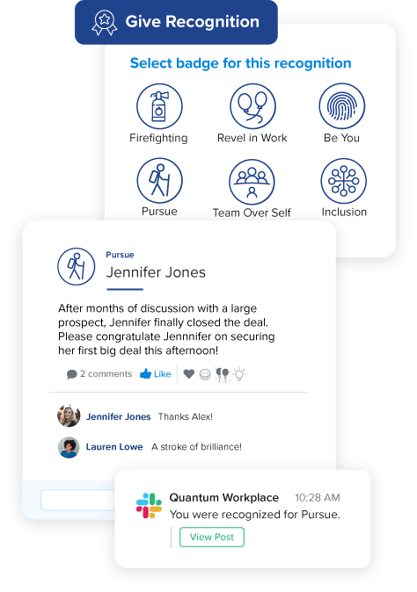
Look for employee recognition software that has:
- Peer-to-peer recognition: allow any employee to easily celebrate another
- Automated milestones: always remember work anniversaries
- Customized badges: tie recognition to cultural values that matter
- Social newsfeed: create a public and fun celebration space
- Integrated notifications: amplify success stories to Slack and Teams
4. Collect and share feedback.
Great companies are built on trust, and trusting cultures are built on feedback. A strong feedback culture correlates with a highly engaged workplace.
The right software can make sure your teams are getting the feedback they need to succeed. Continuous feedback should be individualized, constructive, and unbiased.
Choose a feedback tool that helps you create a feedback culture across the organization. Look for:
- Flexible frameworks: collect any type of feedback with multiple configuration options for requesting and giving feedback
- AI-powered tools: Give thoughtful, real-time feedback within minutes
- Easy access: empower anyone to request or give feedback in minutes
- Automated cycles: initiate feedback based on calendar or employee milestones
- Actionable analytics: identify and act on development opportunities
- Curated templates: provide best-practice guidance and collect consistent analytics across the organization
5. Track vital talent metrics.
Talent reviews enable informed, data-driven talent decisions, utilizing essential data points. They should be frequent, unbiased, and rooted in data. Leaders need to know who is doing the best work, who is ready for promotion, and who is at risk of leaving.
Talent reviews help:
- Track and evaluate performance
- Identify and coach performers who need more support
- Develop and retain top talent through effective talent management strategies
- Intervene before employees burn out or quit
Talent review tools can help you track talent metrics and streamline your process. Look for features that simplify and streamline your talent review process, such as:
- Reliable performance feedback: collect actionable and objective ratings with our simple framework
- 9-box or 4-quadrant visualization: quickly identify talent risks, and those ready for promotion or development
- Calibration settings: allow multiple raters and easily filter data for effective calibration sessions
- Collaboration tools: comment and add talent insights over time
- Integrated succession planning: seek successor nominations and automatically pull ratings into succession plans
6. Identify top talent and develop successors.
Proactively identifying talent gaps minimizes business disruption and fosters a culture of growth. Visibility into critical roles and talent is the first step to creating a board-worthy succession planning strategy.
Start by outlining the roles that are most important to your business function. The C-suite is a no-brainer. But don’t neglect other critical or specialized roles.
Once you have visibility, you can create targeted development pathways for talent.
Succession planning tools provide actionable reports on talent pipeline, readiness, and risk with a few clicks. If your performance management system is fully integrated, you can quickly understand:
- Who your emerging leaders are
- When they’ll be ready to take on key roles and explore potential career paths
- Where your talent gaps are
Look for succession planning software that has:
- Collaborative nomination process: request nominations and performance details from any leader or manager
- Readiness tracking: track candidate readiness by 12-month increments to see progress over time
- Integrated performance: see candidate performance ratings and development goals
- Diversity visibility: align succession plans with diversity goals
- Personalized, board-ready insights: share real-time insights with stakeholders
12 performance management system questions to ask when evaluating a solution
When choosing the right solution for you, there are many things to consider to meet your unique needs. We’ve compiled a list of 12 questions you should ask to get the most out of your performance management system.

Big-picture evaluation questions
When building or adapting your performance management system, it’s important to understand the why behind your performance initiatives. You must uncover the opportunities and obstacles you want your system to help you navigate. This will help you gain insight into whether your system is the right fit or not.
1. Why is it important for us to have staff performance management software?
Effective performance management is essential to driving business success. But juggling several performance activities at once is time-consuming for managers and employees. Overwhelm results in miscommunication, dropped balls, and frustration all-around.
A performance management system helps leaders organize and prioritize activities. The solution you choose should depend on why you’re investing in a performance management system. This will help guide decision-making and position the business case to other stakeholders.
2. What should our performance management system do for us?
It's also important to consider specific features and capabilities you’re looking for. Choosing a system with lots of bells and whistles isn’t always the right move. If it doesn’t align with the core functions you need to improve performance and streamline process, it's just noise.
Consider what your performance management goals and needs are. What do you hope to gain from the software?
This might include:
- Communicating expectations and accountabilities
- Aligning goals with the organization
- Engaging and retaining top talent
- Developing and coaching employees
- Promoting critical thinking, agility, and innovation
- Motivating employees toward success
3. What's going well with our current system, and what's not?
Assess what processes are working well and what needs improvement. Pick a performance management solution that addresses gaps and enhances bright spots. If you're not sure what's going well and what's not, your employee engagement survey is a great place to uncover insights!
4. What opportunities do we have now vs. in the future?
As you evaluate software options, look for both short- and long-term opportunities.
A performance management system can help you fill obvious gaps in the short-term. For example, it can help you transition from annual reviews to quarterly 1-on-1s. It can help you make employee recognition public. Or it can help you create team-based goals to further align employee efforts with the organization.
But performance management systems can also help you with long-term opportunities like:
- Implementing continuous performance conversations
- Opening feedback to all employees and instances
- Building agile and aligned goals across the company
Software Evaluation Questions
Use these questions to understand specific capabilities and features you need.
5. What aspects of performance management does the system support?
You need to make sure the system you choose has the tools your managers need to better serve their teams. Ask your managers what they think might help them become better people leaders. Their feedback can help uncover pain points and opportunities you might not have considered.
- Could they benefit from a peer-to-peer recognition board to make sure their employees feel valued?
- Do they need a transparent goal setting and tracking system to ensure team alignment?
- Would 1-on-1 meeting technology foster better manager-employee communication?
- Would 360 feedback help both them and their employees grow and develop in their roles?
- Could AI-powered performance review tools help teams focus more on engagement and growth?
The performance management software you choose should be a benefit (not a burden) for managers.
6. Is the performance management software customizable to our culture?
Ideally, your performance management software will provide you with some structure and process. For example, a system could include one-on-one meeting templates and a suggested cadence for meeting.
That's great, but make sure the provider you choose allows for some flexibility. Your company's culture is unique and constantly evolving. Choose a performance management software that can fit your needs now and in the future.
Take personalization one step further and find software that lets you:
- Customize employee profiles
- Include images, videos, or gifs in posts and updates
- Incorporate your company branding
- Put your core values front and center
7. Does the developer use their own performance management software?
You'd be surprised how common this actually is. If a provider doesn’t use their own tools, your company shouldn’t be either. Enough said.
8. Does the performance management software integrate with other systems?
The last thing your managers need are more systems, more passwords, and more hassle. Ask your potential software provider if their tools integrate with other systems your managers use in their everyday workflow.
At the very least, your performance management software should integrate with your HRIS so all employee data stays up to date. If your potential provider doesn't have the integration you need, see if they’ll make it happen for you.
Service Evaluation Questions
Finally, it’s important to evaluate the supporting service behind the software.
9. How easy is implementing performance management system?
The easier it is to implement a program, the easier it will be to get buy-in from managers and employees. Look for a performance management system that prioritizes ease of use and has strong customer support. You'll want help:
- Training and onboarding new users
- Answering technical questions
- Troubleshooting issues
- Spurring adoption
10. Can we ensure manager and employee adoption of the system?
The last thing you want to do is invest in performance management software that your teams don't use. Ask potential software providers how they encourage organizational adoption. The best systems will:
- Provide admins with log-in and usage stats
- Nudge users who haven't been active in a while
- Display recent activity for all employees to see.
But, if we're being honest, none of the above should be needed to drive adoption.
The best performance management software will be a no-brainer for managers and employees. It will earn adoption all on its own by the value it creates.
Ask software providers if they have a free trial of their performance management system. This will help you see if it meets your workforce's needs.
11. What is the vendor’s level of support?
When implementing a new system, you want to know your vendor has your back.
Some vendors are only involved with the initial software installment and setup. Then they leave it to you to figure out how to use it, communicate about it, and get the most from its features. This means you’re less likely to enjoy the full value and potential of your new system.
Look for a vendor that offers reliable service every step of the way. From sales conversations and new customer calls to implementation plans and coaching support.
When evaluating vendors look for things like:
- Software and user reviews
- Support team ratings or "time to respond"
- Availability of support (chat, phone, email)
- NPS score of customers
- Resources like webinars and help libraries
12. Can the software provider help us measure impact?
Any top performance management software worth its salt can prove its impact. Make sure your system can measure what's important to you and your leadership team.
Comparing performance management management solutions
Effective performance management is crucial. But how do you choose the right tool for the job? It's important to explore and compare various performance management solutions to make a well-informed decision.
.png?width=900&height=600&name=Essential-elements-of-employee-engagement-software_blog-image%20(2).png)
HRIS Solutions
HRIS solutions offer broad HR functionalities, including employee records, payroll, and benefits administration. However, they often have limited features compared to more specialized HR tools. They may be convenient and cost effective. But they don't offer the depth required for effective and comprehensive performance management strategies.
Point Solutions
Point solutions are designed specifically for performance management. They offer advanced features such as goal setting, continuous feedback, and detailed analytics. They enable organizations to thoroughly and effectively monitor and enhance employee performance.
Basic Office / Google Tools
Basic tools like Google Forms and Word docs are free and easy-to-use. However, they lack the comprehensive features, automation, and analytics of more robust performance management platforms. While they can be quick and cheap for simple feedback needs, they can't support long-term performance management strategies.
Manual Spreadsheets
Manual spreadsheets that are used for performance tracking are low-cost but time-consuming. They are not scalable for tracking employee performance over time and are prone to human error. Additionally, spreadsheets make it difficult to uncover actionable insights, hindering effective performance management.
Best performance management systems for 2025
Quantum Workplace
Quantum Workplace’s performance management tools help managers grow, develop, and align their teams. They empower managers to coach and drive business impact, with tools like:
The company's employee engagement suite helps organizations develop a holistic employee listening strategy. Engagement, pulse, and lifecycle surveys help leaders uncover insights and improve the employee experience.
Quantum Workplace has been in the employee success space for more than 20 years. It is the survey engine behind Best Places to Work.
The company has some of the happiest customers in the HR tech space. It has an impressive, above average NPS score and boasts an average support response time of less than one hour. Quantum Workplace provides support for all users, not just admins.
Reviewers appreciate its:
- User-friendly interface
- Deep insights
- Customization capabilities
- AI-assisted features that save time
However, some users have encountered challenges with navigation and a need for more administrative control than is currently available.
Build high performing teams for a high performing business -- book your demo now >>
Lattice
 Lattice is an AI-powered people platform that helps HR teams enhance manager effectiveness, streamline operations, and use workforce insights to drive business success.
Lattice is an AI-powered people platform that helps HR teams enhance manager effectiveness, streamline operations, and use workforce insights to drive business success.
Users appreciate Lattice's user-friendly interface. They like the ability to track personal and professional goals and the platform's seamless integration with other systems. Users also highlight the company's responsive and knowledgeable customer support.
However, some have encountered challenges with a lack of customization and confusing features like OKRs in goal setting. Users have also expressed concerns about privacy and confidentiality due to bugs.
Culture Amp
 Culture Amp is a platform that helps collect and analyze employee feedback; develop high-performing teams; recognize success; drive employee development; and retain talent.
Culture Amp is a platform that helps collect and analyze employee feedback; develop high-performing teams; recognize success; drive employee development; and retain talent.
Users appreciate its user friendly-interface and ability to gather and analyze employee feedback. They also highlight a seamless integration with HRIS.
However, some users note limitations with the platform’s navigation and limited customization. They've faced issues with translation, and a steep learning curve for new users due to the platform's many features. Some have expressed disappointment with a slow response from support.
15Five
 15Five’s performance management platform helps businesses and employees thrive. They combine generative AI, custom analytics, and human-centered principles.
15Five’s performance management platform helps businesses and employees thrive. They combine generative AI, custom analytics, and human-centered principles.
15Five enables HR leaders to boost engagement, performance, and retention. It provides tools such as 360 reviews, engagement surveys, goal tracking, and manager development. You can also get regular feedback through guided one-on-ones and check-ins.
However, some users felt customer support could be more responsive. Others thought the platform can be overwhelming to set up due to its many features.
PerformYard
 PerformYard is a performance management tool designed to support professional development and social empowerment. It's geared toward small businesses. It serves as a centralized hub for managing annual review documents and process.
PerformYard is a performance management tool designed to support professional development and social empowerment. It's geared toward small businesses. It serves as a centralized hub for managing annual review documents and process.
Reviewers appreciate PerformYard for its intuitive interface, customizable options, and simple performance reviews. This makes it easier for managers and employees to establish goals, give feedback, and monitor progress.
However, some users have noted challenges with navigating the platform. Additionally, there are concerns that the platform may be too generic.
Leapsome
 Leapsome is a people enablement platform used to connect performance management, employee engagement, and learning. It offers tools for goals and OKRs management, performance reviews, employee development, engagement surveys, feedback, compensation, and more.
Leapsome is a people enablement platform used to connect performance management, employee engagement, and learning. It offers tools for goals and OKRs management, performance reviews, employee development, engagement surveys, feedback, compensation, and more.
Users appreciate its user-friendly interface and the ability to provide public and private praise and feedback. They praise the platform's ability to set goals, and the emphasis on anonymity and confidentiality of feedback.
However, some have noted a steep learning curve and hefty navigation challenges. Others have expressed limited customization in reporting, slow load times, and a need for a more visually appealing interface.
Moving toward continuous performance management
Performance management typically falls into two categories: traditional and continuous. Each organization is unique. A one-size-fits-all solution doesn't exist. The reality is that many companies need to strike a balance between the two.
Traditional performance management usually involves annual or semi-annual reviews. They focus on past performance within a structured framework. In contrast, continuous performance management emphasizes regular feedback and positions managers as coaches.
Shifting from one approach to another doesn’t have to be an all-or-nothing transition. It’s better to start where you are and gradually improve. To adopt a more continuous performance management strategy, organizations should:
- Take small steps: Start by increasing the frequency of feedback or establishing regular 1-on-1s.
- Involve employees: Seek employee input to foster buy-in for the changes.
- Support managers: Provide training for managers to help them shift from evaluators to coaches.
- Leverage technology: Research indicates that robust technology is essential for integrating performance management into daily operations for your teams.
- Communicate effectively: Ensure the entire organization understands the new approach and its advantages.
- Analyze feedback and adapt: Use feedback on the new process to refine and improve it.
For many organizations, performance management is an ongoing journey. This evolution is perfectly acceptable. Continue to iterate and build upon the successful practices and habits you’re developing.
Quantum Workplace's Performance Pathways
In performance management, a universal approach isn’t effective. Conventional methods often fail to engage employees and don’t facilitate their best work.
Quantum Workplace can help you develop a process that suits your organization’s specific needs. It will take into account your unique characteristics and performance management maturity.
Our People Insights Team developed Performance Pathways to help you get started. These customizable frameworks enable you to quickly launch an effective program, without having to design it from scratch.
Ready to make your performance management process a pillar of employee success? Download our eBook to learn how to create a strong performance management strategy for your organization.
If you'd like to see if Quantum Workplace would be a great fit for your organization, book a custom demo today!
Performance Management Software FAQs
What is a performance management system?
A performance management system is a structured approach and technology used by organizations to monitor, evaluate, and improve employee performance. It aligns individual goals with organizational objectives to enhance productivity and development.
Why is implementing a performance management tool important?
Implementing performance management software ensures that employees receive regular feedback, understand expectations, and have clear development paths. This alignment fosters motivation and contributes to achieving organizational goals.
What are the key components of effective performance management?
An effective system typically includes goal setting, continuous feedback, performance reviews and one-on-one meetings, employee growth and development programs, employee recognition and rewards, talent reviews, and succession planning.
How does a performance management system differ from a traditional performance appraisal?
Traditional performance appraisals are often annual reviews focusing on past performance. In contrast, a performance management system leverages an ongoing process that emphasizes continuous improvement, regular feedback, and future development.
What challenges might organizations face when implementing a performance management system?
Challenges can include resistance to change, inadequate training for managers, lack of clear objectives, and potential biases in evaluations. Addressing these issues requires careful planning and communication.
How can technology enhance the effectiveness of performance management?
Technology can streamline processes by providing platforms for real-time feedback, tracking progress, setting reminders for evaluations, and analyzing performance data to inform decision-making. Ideally, these processes will integrate into manager and employee workflows, reducing the administrative burden of teams. Technology should also surface data and actionable insights that help teams and the business take action around performance barriers and opportunities.
What role do employees play in the performance management process?
Employees are active participants; they set personal goals aligned with organizational objectives, engage in self-assessment, seek feedback, and take initiative in their professional development.



